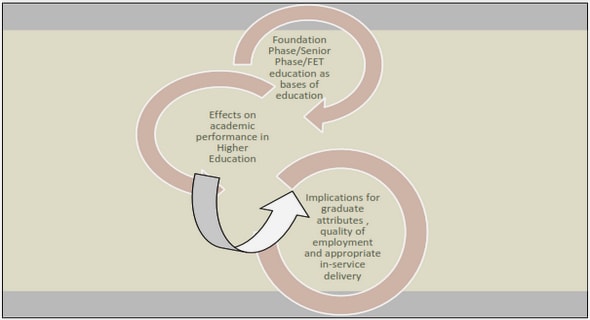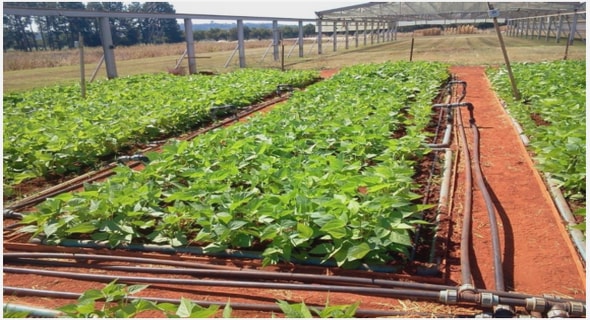Get Complete Project Material File(s) Now! »
Chapter 1 of this thesis provides a summary of the importance of grain legumes and effect of drought in common bean and soybean production. It also provides an overview of previous research on the effect of drought stress on legumes including shoot and root physiological performances as well as symbiotic nitrogen fixation ability. Further, the rationale, aim and objectives of the study are also presented at the end of the chapter.
Chapter 2 reports the results obtained for determining performance of different soybean cultivars under drought conditions in a growth chamber experiment. In particular, this chapter deals with the identification of easily measurable traits, such as gas exchange, plant growth and symbiotic nitrogen fixation, for plants grown under well-watered and drought conditions.
Chapter 3 reports about the physiological performance of different common bean inbred lines with varying degrees of drought tolerance grown in a phytotron under either adequate water supply or drought stress conditions. Performance traits measured under drought for soybean were also measured in order to identify performance traits more widely applicable for legumes.
In Chapter 4 the field performance of common bean inbred lines is reported. Especially this section considers the potential role of root architectural and morphological traits for identifying superior performing bean lines under drought conditions. The relationship of productivity traits with root system traits is also outlined for different nitrogen-fixing lines.
Chapter 5 reports the results obtained for evaluation of common bean lines for water use efficiency and symbiotic nitrogen fixation ability measured using stable carbon isotope discrimination (CID) and 15N natural abundance respectively. Furthermore, the relationships of CID and 15N natural abundance with plant productivity as well as morphological and architectural root traits are outlined in this chapter.
Chapter 6 presents the results obtained for determining the field performance of soybean cultivars. In particular, results of root morphological and architectural traits, plant productivity parameters, WUE (CID) and symbiotic nitrogen fixation (15N natural abundance) performance of these soybean cultivars grown under drought and well-watered are reported. Finally, this chapter also deals with the results obtained on the association of especially CID and 15N natural abundance with root and productivity performance traits.
Chapter 7 summarizes the findings and relevant information generated from this PhD study with the focus of how this study contributed to an advancement of the physiological understanding of the response of the shoot-root system of legumes for drought stress. It further highlights the importance of the use of root system architectural parameters, symbiotic nitrogen fixation traits together with other physiological traits for identification of drought tolerant legumes. Moreover, in this chapter a recommendation for application of performance traits for particular growth condition and legume type is provided. Finally, this chapter also outlines the possible future research activities which might help for using morpho-physiological performance traits for multiple stresses and for wider application in other tropical legumes. This is followed by the reference list of the citations used in this thesis and appendix.
TABLE OF CONTENTS :
- ABSTRACT
- THESIS COMPOSITION
- ACKNOWLEDGEMENT
- DEDICATION
- ABBREVIATIONS AND SYMBOLS
- LIST OF FIGURES
- LIST OF TABLES
- LIST OF APPENDIX TEBELES
- CHAPTER ONE: GENERAL INTRODUCTION
- 1.1 Importance of grain legumes
- 1.1.1 Production of common bean and soybean
- 1.1.2 Consumption and economic importance
- 1.1.3 Legumes and soil fertility
- 1.2 Legumes and drought stress
- 1.2.1 Importance of drought stress
- 1.2.2 Research on drought stress
- 1.2.3 Physiological effect of drought on legume performance
- 1.2.3.1 Leaf water potential
- 1.2.3.2 Photosynthesis
- 1.2.3.3 Water use efficiency
- 1.2.3.4 Plant growth, biomass and productivity
- 1.3 Effect of drought on roots
- 1.3.1 Root system of legumes
- 1.3.2 Root architecture and morphology
- 1.3.3 Effect of drought on nodules
- 1.3.4 SNF and plant biomass and productivity
- 1.3.5 Methods of SNF measurement
- 1.3.5.1 15N analysis
- 1.3.5.2 Nitrogenase activity assay (ARA)
- 1.4 Rationale for study
- 1.5 Working hypothesis and aim of the study
- CHAPTER TWO: CHARACTERIZATION OF DROUGHT TOLERANCE TRAITS IN
- NODULATED SOYBEANS
- 2.1 Abstract
- 2.2 Introduction
- 2.3 Material and methods
- 2.3.1 Plant material and growth conditions
- 2.3.2 Photosynthesis measurements and calculation of instantaneous
- water use efficiency (IWUE) values
- 2.3.3 Leaf water potential
- 2.3.4 Water content of vermiculite
- 2.3.4 Biomass
- 2.3.5 Nitrogenase activity measurement
- 2.3.6 Statistical analysis
- 2.4 Results
- 2.4.1 Photosynthesis, stomatal conductance and water use efficiencies
- 2.4.2 Plant biomass and shoot to root ratio
- 2.4.3 Nodule parameters and symbiotic nitrogen fixation (SNF)
- 2.5 Discussion
- CHAPTER THREE: PERFORMANCE OF COMMON BEAN UNDER WATER
- DEFICIT IN A CONTROLLED ENVIRONMENT
- 3.1 Abstract
- 3.2 Introduction
- 3.3 Materials and methods
- 3.3.1 Plant material and growth conditions
- 3.3.2 Plant growth
- 3.3.3 Gas exchange
- 3.3.4 Leaf water potential
- 3.3.5 Soil water content
- 3.3.6 Biomass and leaf area
- 3.3.7 Symbiotic nitrogen fixation (SNF)
- 3.3.8 Statistical analysis
- 3.4 Results
- 3.4.1 Vermiculite water content and leaf water potential
- 3.4.2 Effect of drought on gas exchange
- 3.4.3 Drought effect on plant development and biomass distribution
- 3.4.4 Nodule performance and symbiotic nitrogen fixation (SNF)
- 3.4.5 Nodule performance association with growth and gas exchange
- 3.5 Discussion
- CHAPTER FOUR: CHARACTERIZATION OF ROOT TRAITS IN RELATION TO
- SEED YIELD OF COMMON BEAN LINES GROWN UNDER WELL-WATERED AND
- DROUGHT CONDITIONS IN THE FIELD
- 4.1 Abstract
- 4.2 Introduction
- 4.3 Material and methods
- 4.3.1 Experimental site
- 4.3.2 Plant material
- 4.3.3 Pest control
- 4.3.4 Experimental design
- 4.3.5 Measured parameters
- 4.3.5.1 Soil moisture content
- 4.3.5.2 Chlorophyll content
- 4.3.5.3 Root architecture
- 4.3.5.4 Root morphology analysis
- 4.3.5.4.1 Soil coring
- 4.3.5.4.2 Root washing and scanning
- 4.3.5.5 Biomass partitioning and seed yield measurement
- 4.3.6 Statistical analysis
- 4.4 Results
- 4.4.1 Soil moisture content and chlorophyll content
- 4.4.2 Root morphology and architecture
- 4.4.3 Days to maturity, biomass and yield
- 4.5 Discussion
- CHAPTER FIVE: WATER USE EFFICIENCY AND SYMBIOTIC NITROGEN
- FIXATION OF COMMON BEAN LINES UNDER WELL-WATERED AND DROUGHT
- CONDITIONS IN THE FIELD
- 5.1 Abstract
- 5.2 Introduction
- 5.3 Material and methods
- 5.3.1 Plant material
- 5.3.2 Parameters measured
- 5.3.2.1 Nodule size
- 5.3.2.2 Carbon isotope discrimination / 15N natural abundance
- 5.3.3 Statistical analysis
- 5.4 Results
- 5.4.1 Stable carbon isotope discrimination
- 5.4.2 Nitrogen fixation
- 5.4.2.1 Relation of δ15N and carbon isotope discrimination, as well as with
- root and productivity traits
- 5.5 Discussion
- CHAPTER SIX: ADAPTATION OF SOYBEAN CULTIVARS TO DROUGHT STRESS
- UNDER FIELD CONDITIONS: ROLE OF ROOT ARCHITECTURE, BIOMASS
- PARTITIONING, WATER USE EFFICIENCY AND SYMBIOTIC NITROGEN
- FIXATION
- 6.1 Abstract
- 6.2 Introduction
- 6.3 Materials and methods
- 6.3.1 Plant material and experimental procedure
- 6.3.3 Planting and experimental layout
- 6.3.4 Measured parameters
- 6.3.4.1 Chlorophyll content
- 6.3.4.2 Root architecture
- 6.3.4.3 Root morphology analysis
- 6.3.4.4 Biomass partitioning and seed yield measurement
- 6.3.4.5 Nodule size, carbon isotope discrimination and 15N natural
- abundance
- 6.3.5 Statistical analysis
- 6.4 Results
- 6.4.1 Chlorophyll content
- 6.4.2 Root architecture and morphology
- 6.4.3 Plant biomass, days to maturity and seed yield
- 6.4.4 Nodule size, carbon isotope discrimination /15N natural abundance
- 6.4.5 Association between carbon isotope discrimination and 15N natural
- abundance traits with seed yield and root traits
- 6.5 Discussion
- CHAPTER SEVEN: GENERAL DISCUSSION AND FUTURE
- RESEARCH
- REFERENCES
- APPENDIX
GET THE COMPLETE PROJECT
Investigation of the physiological responses in soybean and common bean to water deficit


